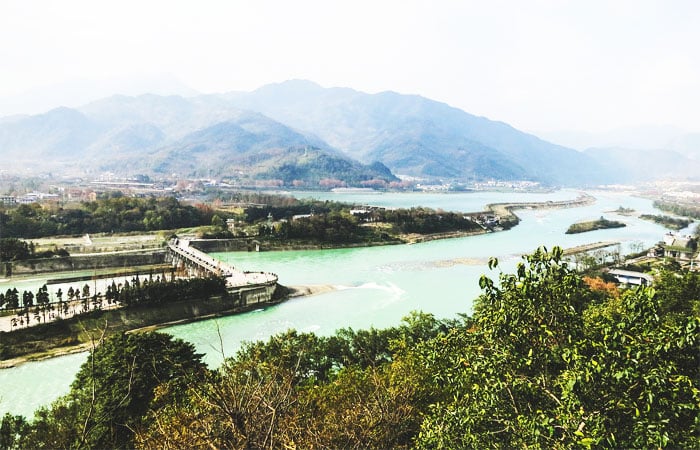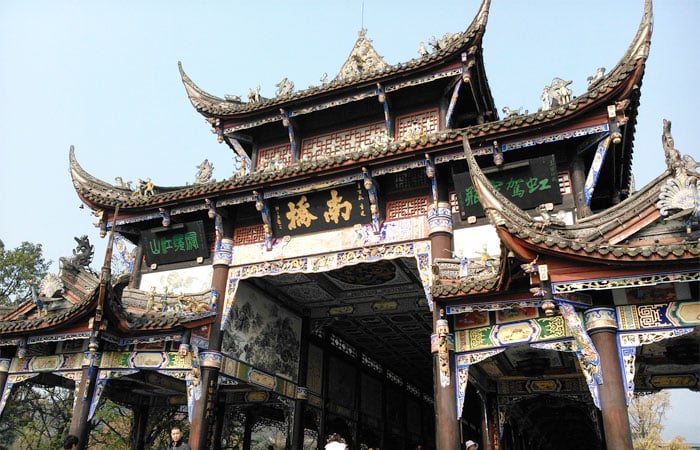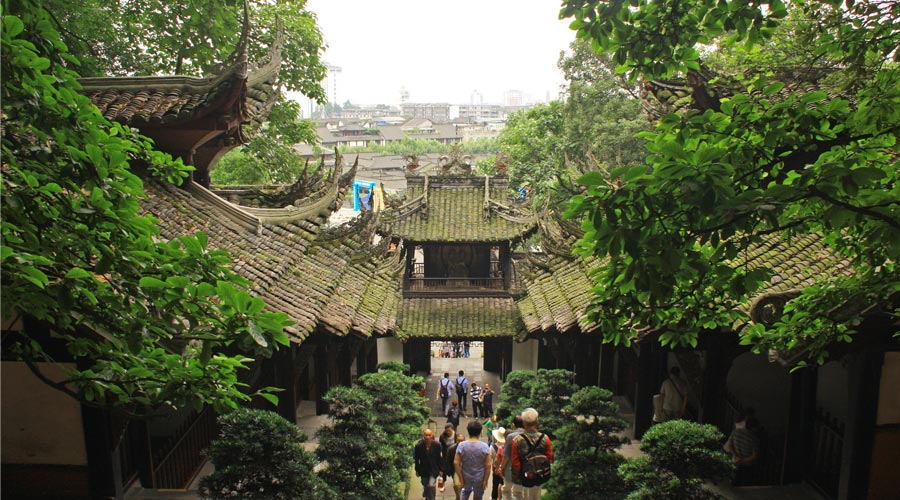Dujiangyan City is located in the west of Chengdu – just 48 km from downtown – and is celebrated as the “Origin of the Land of Abundance” thanks to its world-famous Dujiangyan Irrigation System. (Photo by © marcoven via Flickr)
Introduction & Climate
Situated in the subtropical monsoon climate zone of the Sichuan Basin, Dujiangyan City enjoys mild temperatures and abundant rainfall. With an average low of 4.6℃ in winter and a high of 24.4℃ in summer, the city remains pleasant throughout the year. The region receives roughly 1,243.8 millimeters of rainfall annually, making it ideal not only for agriculture but also for a comfortable living environment. Visitors might also consider pairing their trip to Dujiangyan with a visit to Chengdu – just a short journey away.
When to Visit
The best time to explore Dujiangyan is from April to October. During these months, you can take advantage of the cool yet comfortable weather at the Dujiangyan Irrigation System and even enjoy the local summer resort attractions and the lively Hongkou drifting beer festival on summer nights.

Where to Stay
Dujiangyan offers a range of accommodations to suit every traveler. Budget visitors will find plenty of affordable hostels, whereas those seeking luxury can choose from upscale hotels. Many of these lodgings are conveniently situated along Jianshe Road, Dujiangyan Avenue, and Guan Jing Road – with prices generally increasing as you get closer to major scenic sites and peak holiday periods.
Dujiangyan City Tourist Spots
World Heritage Sites
Dujiangyan is home to two World Heritage Sites: the remarkable Dujiangyan Irrigation System and Mount Qingcheng, a revered Taoist mountain in China.
Giant Pandas
The Dujiangyan Giant Panda Base or Conservation and Research Center for the Giant Pandas (CCRCGP) in Shiqiao Village, Qingchengshan Town, is dedicated to enhancing the living conditions and ecological protection of these beloved animals.
Summer Resort
Beat the heat at the popular Summer Resort, where both locals and tourists unwind and enjoy the balmy weather during the warmer months.
Dujiangyan Irrigation System
Located on the Minjiang River in Dujiangyan City – just 56 km from Chengdu, the capital of Sichuan province – the Dujiangyan Irrigation System stands as one of the most impressive ancient engineering feats in the world. Built over 2,300 years ago, this system not only provides vital irrigation for the Chengdu Plain but also protects the region from devastating floods. Even after surviving natural disasters, including the 2008 Wenchuan earthquake, this marvel continues to nurture the “Land of Abundance.” For more details on the dynamic Chengdu area, keep exploring our guides.
Historical Origins
Designed and constructed around 200 B.C., the Dujiangyan Irrigation System is remarkable for being the world’s only non-dam irrigation project still in use today. In an era when the Minjiang River frequently flooded the fertile lands, local official Li Bing and his son devised a plan to control the water flow without hindering river navigation – essential for military and trade purposes. Funded by King Zhao of the Qin Dynasty and built with the labor of ten thousand workers over eight years, the system’s ingenious design diverted devastating floods and propelled the region into an era of agricultural prosperity.
| Ticket Prices & Opening Hours | |
|---|---|
| Entrance Ticket | 80 Yuan |
| Sightseeing Bus | 15 Yuan (round trip) / 10 Yuan (single trip) |
| Hours | |
| March – November | 08:00 – 18:00 |
| December – March | 08:00 – 17:30 |

Main Water Projects
Yuzui
The Yuzui project is a water-dividing dike that splits the Minjiang River into two parts. The Outer River, running along the western section, is dedicated to flood discharge, while the Eastern Inner River channels water for irrigation throughout the Chengdu Plain.
Feishayan
As a crucial flood discharge project, Feishayan safeguards the plain from overflowing. In addition to managing excess water from Baopingkou, it also plays an essential role in desilting and regulating the water’s flow.
Baopingkou
Operating like a control valve, Baopingkou automatically manages the water flow in the Inner River, ensuring a balance between irrigation needs and flood prevention – a feature that has long fascinated visitors with its blend of engineering prowess and natural beauty.
Cultural Landmarks
Erwang Temple
Nestled on the hillside along the banks of the Ming River, Erwang Temple honors Li Bing and his son for their monumental engineering achievements. The temple showcases statues of these historical figures in its main hall, while ancient inscriptions on its stone walls – remnants of Qin Dynasty water control wisdom – add to the site’s rich narrative. Visitors can take in sweeping views of the entire irrigation system from the temple grounds.
Fulong Temple
Located within the tranquil Lidui Park, Fulong Temple was established during the Jin Dynasty in honor of Fan Changsheng, a key figure in Tianshi Taoism, and later Li Bing. Today, a carved stone statue of Li Bing (dating to the Eastern Han Dynasty) stands prominently in the temple’s front hall. The lookout pavilion here offers one of the finest panoramic views of Feishayan, Yuzui, and the surrounding landscapes.

Yulei Mountain
On the eastern flank of Erwang Temple, Yulei Mountain is draped in ancient trees and a rich cultural heritage. A section of the Great Wall from the Ming Dynasty traverses its slopes, and the Yulei Pavilion at its peak rewards visitors with breathtaking views of both the irrigation system and the city below.
Anlan Suspension Bridge
Ranked among ancient China’s top five bridges, the Anlan Suspension Bridge spans the Inner and Outer Rivers in Yuzui. Originally built during the Song Dynasty and rebuilt in 1974, this charming bridge is popular for its gentle sway – a whimsical experience for those looking to capture unique photos amidst a stunning natural backdrop.
Getting Around & Visitor Information
Transportation
Though Dujiangyan City does not have its own airport, the nearby Chengdu Shuangliu International Airport is just 70 km away. From the airport, a direct bus service to the Dujiangyan Bus Station takes approximately one hour and 30 minutes. Alternatively, travelers from Chengdu can opt for the bullet bus from Chengdu North Railway Station, which shortens the trip to 30–50 minutes. Local public buses and taxis are readily available to navigate between attractions within the city.
Tourist Guide & Tips
| How to Get There | |
|---|---|
| Chengdu Shuangliu International Airport | Take a direct bus from the airport to Dujiangyan Bus Station. The journey takes about 1 hour and 30 minutes. |
| From Chengdu | Use the bullet bus from Chengdu North Railway Station for a 30–50 minute ride, or catch the bus from Chengdu Chadianzi Bus Station for a 1-hour trip. |
| By Bus & Taxi | Local buses and taxis make it easy to visit the city’s various attractions. |
If you have any additional insights or tips about visiting Dujiangyan, feel free to share your thoughts in the comments below. Our travel experts are always on hand to help you plan the perfect visit.































